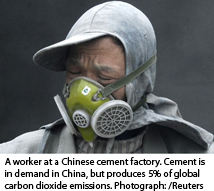China alone could bring world to brink of climate calamity
 Business as usual in China would lead to 2.7C rise by 2050 even if all other countries slash emissions, says energy assistant
Business as usual in China would lead to 2.7C rise by 2050 even if all other countries slash emissions, says energy assistantChina must be far more ambitious in tackling climate change if the international community wants to prevent calamitous levels of global warming, a senior US official told counterparts in Beijing today.
David Sandalow, assistant secretary of state for energy, said the continuation of business as usual in China would result in a 2.7C rise in global temperatures by 2050 even if every other country slashed greenhouse gas emissions by 80%.
“China can and will need to do much more if the world is going to have any hope of containing climate change,” said Sandalow, who is in Beijing as part of a high-level negotiating team that aims to find common ground ahead of the crucial Copenhagen summit at the end of this year.
No effective deal will be possible without the US and China, which together account for almost half of the planet’s carbon emissions.
Since Barack Obama entered the White House, hopes for a closer working relationship on climate change have surged along with a softening of rhetoric, but the official negotiating positions of the two sides remain far apart.
Before arriving for this week’s talks, Todd Stern, the head of the US delegation, said China and other developing nations are not doing enough and “need to take significant national actions that they commit to, internationally, that they quantify.”
China’s position paper says the US and other nations that industrialised earlier should cut emissions by 40% between 1990 and 2020, as well as paying 1% of their GDP to help poorer nations deal with the consequences and causes of climate change.
But behind the scenes, there is scope for compromise on the transfer of clean-carbon technologies by the US and a commitment by China to scale back its emissions relative to economic growth.
In the coming weeks, the government in Beijing is expected to boost its climate credentials with a massive investment in wind, solar, nuclear and other forms of renewable energy.
Sandalow said China deserves credit for the effort it has already made, but he warned that there was mistrust on both sides that should not be allowed to derail the negotiating process.
Last week China’s state-controlled Xinhua News Agency said the US position made it difficult to be optimistic about the prospects for a deal in Copenhagen.
“The key to getting negotiation results will be that the few developed countries do not shift blame on others and reduce emissions first,” it said.
No details of this week’s talks have been made public, but the Chinese Foreign Ministry described the meetings between Stern and deputy prime minister, Li Keqiang as constructive.
The sides agreed to “push forward the Copenhagen climate change conference to yield positive results,” foreign ministry spokesman Qin Gang said.
Regardless of the outcome of the negotiations, the Chinese government aims to move towards a low-carbon economy in its next five year plan, starting from 2011.
“We must incorporate addressing climate change and reducing the intensity of carbon dioxide emissions into national economic and social development plans,” said the summary of a meeting on energy and climate change issues chaired by Premier Wen Jiabao last Friday, according to the central government website.
But even with the shift to renewables, clean car technology and ecologically friendly urban planning, China’s overall emissions are not expected to drop for many years. The most optimistic scenario suggests 2020 may be a peak, but the majority of scholars and government officials do not think carbon consumption in China will fall until at least 2030.
You can return to the main Market News page, or press the Back button on your browser.

